Bed side rails are an effective barrier to stop patients falling out of bed. They are an important device for patient safety, but can cause risks to the patient if they are not used properly, so due care and consideration needs to be taken by care homes and their staff.
In this article we look at the regulations that apply to the use of side rails, and what you need to look out for to ensure the patient is kept safe at all times.
Jump straight to...
Background: Adjustable Beds
Adjustable beds offer the ability to raise and lower at the head and foot end of the bed and are often the next step for people who are starting to struggle with comfort from a more standard bed. The head end raises to help sit you up in bed, and the foot end raises to help elevate your legs and provide more comfort. One example of an adjustable bed is the Eden Premium adjustable bed.
A height adjustable profiling bed provides the advantage of being adjustable in height, in addition to being able to sit you upright and raise your legs. This would be the next stage up from an adjustable bed and would often be the preferred choice for someone who struggles to stand from the bed; needs carers to provide personal care in bed; or if you need equipment to help you to transfer, such as a hoist. One example of a height adjustable profiling bed is the Signature Comfort bed.
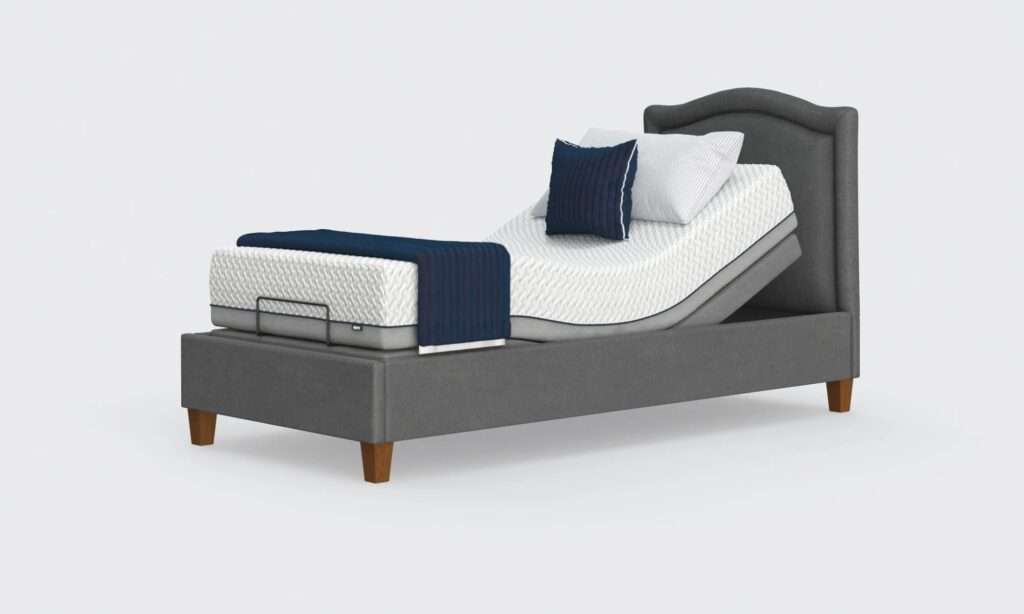
Many people consider whether to order rails as an optional extra when purchasing a bed, in the hope that such rails would either prevent someone from falling out of bed, or could offer support when transferring on and off the bed. There are a variety of different types of bed rails to consider:
Different Types of Bed Rails
Bed lever / bed grab rail / bed support rail:
Different companies refer to these in a number of ways, but ultimately these are small rails that are fitted towards the head of the bed. Their purpose is not to prevent falls from bed but to offer support to the person when rolling or turning onto their side, or to provide a firm support when transferring on and off the bed.
Side rails:
Side rails are longer rails that fit to both sides of the bed, either covering the full length of the bed from headboard to footboard, or extending ¾ of the way down the bed. These rails are widely used to reduce the risk of falls.
The Purpose of Bed Side Rails
Bed side rails are designed to keep patients safe who may be at risk of falling out of bed. This is particularly relevant to those who have dementia or other neurological impairments which make them less aware of their actions. Bed rails come in different types and lengths, some are split, mesh, transparent, or padded for mental health care.
Care must be taken however to ensure they do not pose an entrapment hazard to the patient, by getting their head or limbs stuck between the gaps in the side rails or between the side rail and the bed itself. This is where the regulations come into play to prevent this happening.
Do you need bed/side rails?
Rails may be considered to be a ‘medical device’ and therefore fall under the authority of the Medicines and Healthcare Products Regulatory Agency (MHRA), whose role is to ensure that medical devices are acceptably safe. Sadly there is a great deal of accident data that shows that the use of bed rails can cause risks of injury in certain situations. It is therefore essential that you consider your own circumstances before deciding on whether rails are a good option or not.
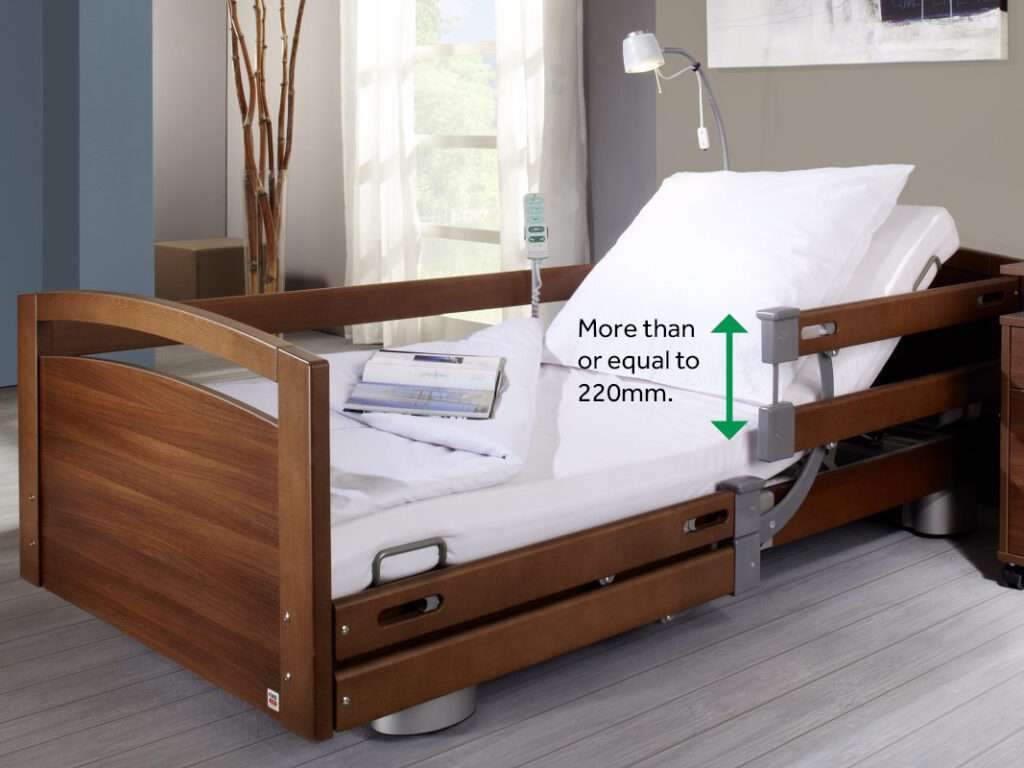
Questions to Ask When Considering the Use of Bed Side Rails
- What are you wanting the rail for?
This is a good starting point! Are you wanting the rail to help you transfer on and off the bed? Are you wanting to reduce the risk of falling out of bed? As mentioned, bed levers are not designed to prevent someone from falling out of bed, so if this is the reason you want a rail, then side rails are the better option. However, you still need to consider several other things before deciding if any type of rail is the right solution.
The following relates to all types of bed rails.
- Compatibility with the bed.
When a bed provider has the option of adding a bed lever or side rails as an accessory, they will have needed to ensure compatibility as part of their legal requirements. Generally the problem with compatibility comes when someone already has a bed and wants to add a bed lever or side rails at a later date. In these situations I would encourage you to have an assessment from your local authority occupational therapy team who would be able to advise you on the appropriateness of rails and may be able to provide a suitable solution from their equipment loan service.
- Your health needs
A person’s physical condition can impact on whether rails are a suitable option. The following may increase the risk of entrapment or injury if rails are used:
- Repetitive or involuntary movements – this can increase the risk of injury through hitting a body part against the rail, or through a body part becoming trapped between the gaps in the rail.
- Dementia, agitation, confusion and/or hallucinations – risks are increased as a person may attempt to climb over or around rails or lack understanding regarding safe use of rails.
- Learning difficulties, where a person may lack the understanding regarding safe use of rails.
- Communication problems – if a person does become caught between gaps in rails, they may have difficulty calling for help.
- High or low body mass, or short in stature (below 4’11 tall) – body shape and size may increase risk of entrapment between gaps in rails.
- Impaired or restricted mobility – if a body part becomes caught between gaps in rails, risks are increased if they cannot free themselves.
- Variable levels of consciousness – the person may be less able to respond to potential dangers.
If any of the above are applicable to your situation, careful consideration needs to be given around the use of rails, as the risk of having a rail may be greater than if a rail isn’t fitted to the bed.
- Your personal circumstances
If you share a bed with another person, it is important to consider their physical characteristics in relation to the use of rails. This is particularly important in relation to sharing the bed with a child, for example co-sleeping with a baby or toddler.
What are the Regulations?
When it comes to side rails, there are certain manufacturing guidelines and regulations concerning their use in care environments that need to be adhered to.
Most side rails are classed as medical devices, which immediately puts them under MHRA guidelines, which are there to ensure medical devices are safe for patient use.
When they are used within registered care environments such as care homes, the Health & Safety at Work Act and Health & Social Care Act apply. Care home providers should already be au fait with these regulations, and staff made aware of the relevant safety rules and procedures that need to be followed. The Care Quality Commission (CQC) is the regulator in this industry to ensure care homes are compliant with the relevant regulations. They have published specific guidance relating to the use of bed side rails, including learnings from previous incidents, which is a great resource for social care providers.
Lastly, the Mental Capacity Act governs the care of patients who are not able to look after themselves due to mental incapacity, and need extra safeguarding and support.
So as you would expect, there is plenty in the statute book to refer to! Whilst we are not able to give any legal advice, we can point you to some of the specific regulations that give detailed guidance about the safe use of side rails.
Staying Compliant
The medical bed standards are the specific ones to look out for when purchasing bed rails and ensuring they are used correctly.
There are two separate standards, one for adults and one for children.
Bed Rail Standards for Adults
BS EN 60601-2-25 is the standard for the dimension of bed rails for adults, including specific measurements for the gaps within the frame and between the frame and headboard.
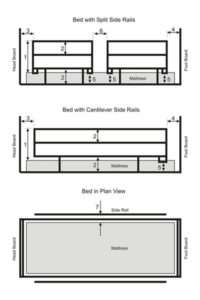
As shown in the diagram, gaps between the horizontal rails (2) should be no more than 120mm so the patient cannot trap their limbs or their head.
Gaps between the sides of the frame and the bed (3, 4, 5) should be no more than 60mm, to avoid entrapment.
The height of the top rail above the mattress (1) should be at least 220mm to prevent the patient falling out of bed.
With split side rails, the gaps between them (6) should also be no more than 60mm. This is an important area to watch being in the middle of the bed, as it is easier for the patient to get their arms and legs caught.
Bed Rail Standards for Children
BS EN 50637:2017 is the standard for children and paediatric beds. You will notice there are two diagrams, one for split and one for continuous side rails, but the principles are essentially the same.
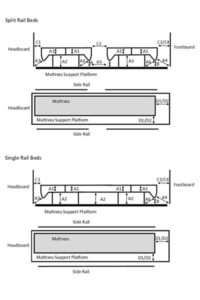
Gaps between the frame (A) should be no more than 60mm.
Gaps between the frame and the bed base, head and foot sections (B & C) should be no more than 40mm.
Gaps between the split side rails (C2 & A5) should be no more than 60mm.
The CubCare is a great example of an advanced paediatric bed for acute environments. The bed sides are clear Perspex and BS EN 50637:2017 compliant, giving visibility to the patient so they don’t feel like they are in a cage. They are electrically height adjustable so can be lowered for easy accessibility.
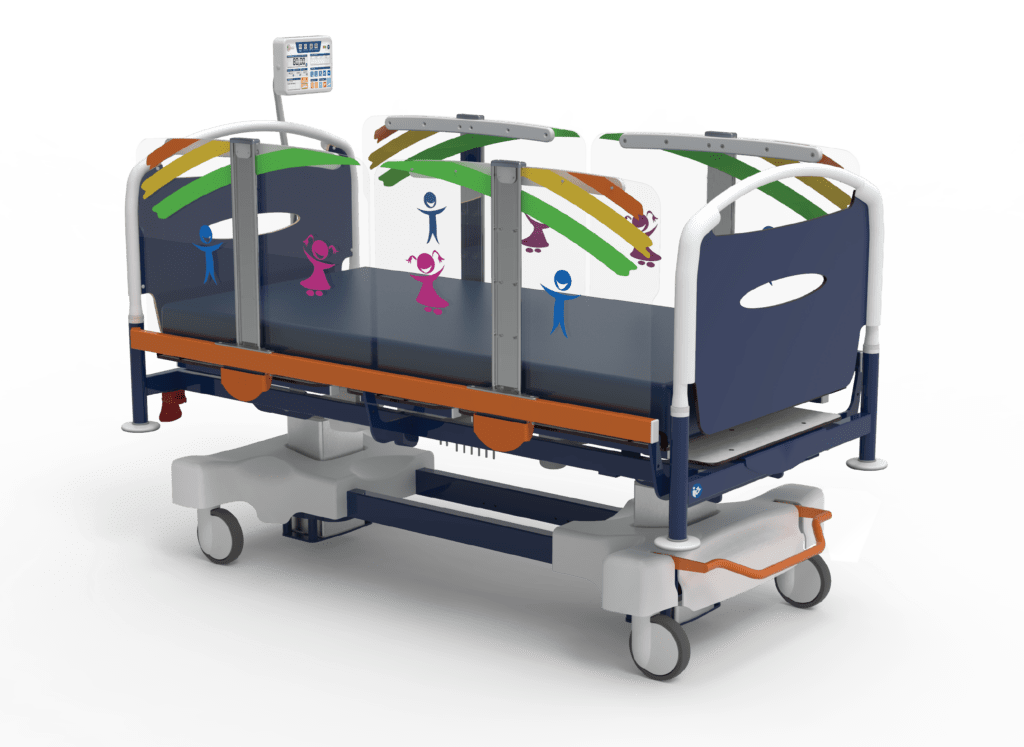
CubCare Paediatric Bed
Tips for Care Homes When Using Side Rails
Risk Assessments
Risk assessments are always a good starting point for using medical devices that require care and training to operate. This risk assessment provided by gov.uk is a useful template, which has been compiled from feedback from bed rail manufacturers and findings of adverse incidents.
Bed and Rail Combinations
Always check the compatibility of beds with detachable side rails; manufacturers should give clear guidelines on this in their operating instructions. Most adjustable and profiling beds come with integral side rails that are offered as an optional accessory, which are the preferred option over bed and rails from separate manufacturers.
Care should be taken when using hybrid mattress or mattress overlays, as these may raise the resting height of the patient in relation to the top rail. This distance should be checked to ensure it is in line with the BS EN 60601-2-25 or BS EN 50637 standards stated previously.
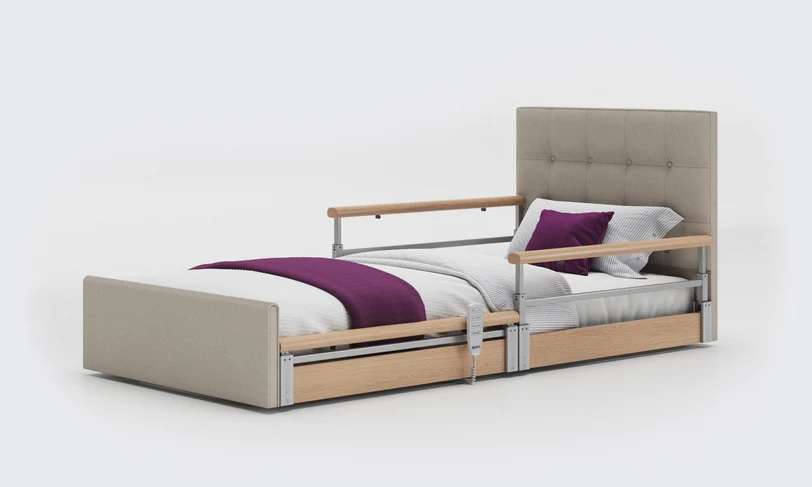
Opera beds have integral side rails
Training
Do staff understand how to fit side rails properly? Incorrect or loose fittings can cause accidents and harm to the patient. Proper training should be given and staff shown how to ensure the bed rail is fitted correctly, possibly with the use of a checklist to cover all essential points.
Maintenance
Ongoing preventative maintenance should be carried out by qualified personnel to ensure the rails are in good condition, and flag up any warning signs. Each rail should have a unique ID that can be used to log maintenance records against, and allow them to be identified if a safety issue arises like a manufacturer recall.
Some common signs of disrepair to look out for are:
- Rust around welds/joints
- Cracking of paint or coating
- Loose fixings
- Bent components
- Missing labels
Alternatives to Bed Rails
Many people think that if they have an adjustable bed, they should have a bed rail regardless, however we would only advocate having a rail if it is needed, either to offer support when transferring or to prevent falls from bed. Where appropriate, it is perfectly fine to have a bed without any rails at all!
If there are concerns that mean the use of rails poses more risks compared to not having rails, then there are some alternative solutions that could be considered, for example:
- Protective covers/bumpers – these offer a padded covering that covers gaps in the rails and offers protection against injury if hitting a body part against the rail or getting a body part caught between the rails, for example if you have involuntary movements.
- Having a low height bed, or floor bed – these lower in height so they are much closer to the floor, reducing the distance that a person would fall if they were to roll or fall off the bed. Having a fall-out mat positioned at the side of the bed would generally also be considered along with a low bed, so that the person is rolling/falling onto a softer surface to reduce the risk of injury.
- Sensor alarms – there are a variety of options available, but this would generally be a sensor mat that sits on the floor at the bedside, and detects if a person gets out of bed, alerting a family member or carer so that quick assistance can be given, reducing the risk of a fall. Your local authority should be able to offer advice in relation to falls detectors and sensor alarms.
Conclusion
Bed rails are designed to serve a purpose, and before making arrangements to fit a rail it is important to consider all factors in whether they are an appropriate solution. If you’re unsure if a bed rail is right for you, we would always recommend that you contact your local authority occupational therapy service who may be able to offer you telephone advice, or alternatively may suggest an assessment of your needs at home.
This article was written in conjunction with Vivid Care, using content previously published on Vivid Care’s blog.














